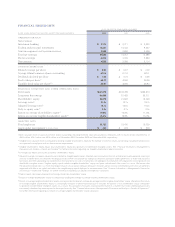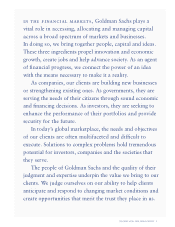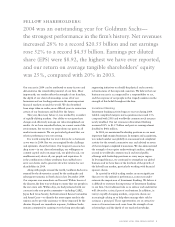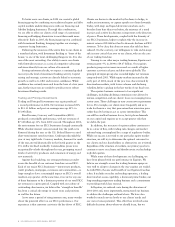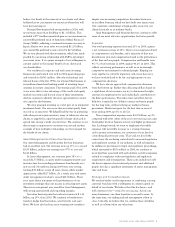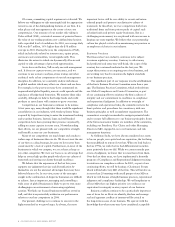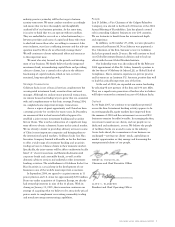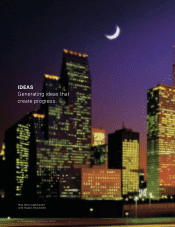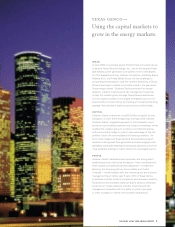Goldman Sachs 2004 Annual Report Download - page 8
Download and view the complete annual report
Please find page 8 of the 2004 Goldman Sachs annual report below. You can navigate through the pages in the report by either clicking on the pages listed below, or by using the keyword search tool below to find specific information within the annual report. Of course, committing capital requires us to take risk. We
believe our willingness to take meaningful risk for appropriate
reward is one of the distinguishing features of our firm. It is
what places risk management at the center of our core
competencies. One measure of our market risk-taking is
Value-at-Risk (VaR), a statistical measure of potential loss in
the value of our trading positions over a defined time horizon
with a specified level of confidence. In 2004, our average daily
VaR was $67 million, 16% higher than the $58 million
average in 2003. During the year, the components of VaR,
which include risks related to interest rates, equity prices,
currencies and commodities, varied significantly. This
illustrates the extent to which we dynamically allocate risk
capital to take advantage of perceived opportunities.
As we have said before, VaR is only one risk management
tool. It does not capture worst case outcomes, and we
continue to use scenario analyses, stress testing and other
analytical tools as key components of our risk management
discipline. In addition, we constantly analyze imbalances
in global markets which may affect our clients and our firm.
For example, in the past year many have commented on
unprecedented global liquidity, narrow credit spreads and the
rapid pace of hedge fund formation. We monitor these risks
carefully, although we believe that hedge funds and credit
products as asset classes will continue to grow over time.
Competition in our businesses continues to be intense.
A few years ago, many thought that there would be significant
consolidation in our industry, with weaker players being
acquired by larger firms trying to enter the investment banking
and securities business. Instead, large and well-funded
competitors have been growing their presence organically,
adding to excess capacity in many areas. Notwithstanding
their efforts, we are pleased with our competitive strength
and breadth across our core businesses.
Many of our competitors are much larger and conduct a
wider range of businesses than we do. We do not view the size
of our firm as a disadvantage, because we have never been
constrained by a lack of capital. Furthermore, in most of the
businesses in which we compete, we are at least as large as
any other competitor. We view our focus as an advantage that
helps us attract high-quality people who share our culture of
teamwork and serving our clients through excellence.
We believe that the experience of the last few years
supports our judgment that size and diversification by
themselves are not the universal advantages that many have
believed them to be. In our view, many of the synergies
sought in the combination of disparate businesses are difficult
to achieve. Just as important, managing and controlling a
wide array of global businesses is likely to prove even more
challenging in an environment of increasing regulatory
scrutiny. We think our focused business model has served us
well, and that was particularly evident in our performance
relative to our key competitors in 2004.
Our greatest challenge is to continue to execute to the
highest standard as we grow larger. As always, the most
important factor will be our ability to recruit and retain
talented people and preserve our distinctive culture of
teamwork. In this effort, we face competition both from
traditional firms and from private pools of capital such
as hedge funds and private equity businesses. But in a
challenging environment, we are pleased with our success in
keeping our team together. We believe that our partnership
culture has played a vital role in maintaining our position as
an employer of choice in our industry.
BusinessPractices
The financial services industry continues to be subject
to intense regulatory scrutiny. Contrary to what many
had predicted and some may still think, the scope of this
scrutiny has continued unabated in the last year. We
accept this scrutiny as an ongoing part of our business, and
are working very hard to maintain the highest standards
in our business practices.
One significant part of our response was the establishment
of the firm’s Business Practices Committee more than a year
ago. The Business Practices Committee, which evolved from
our Global Compliance and Control Committee, is part
of our continuing effort to reinforce the firm’s culture of
integrity and our commitment to excellence in compliance
and reputational judgment. In addition to oversight of
compliance and operational risks, the committee reviews the
firm’s policies and procedures for consistency with our
business principles as well as regulatory requirements. The
committee’s oversight is intended to mitigate potential risks
and to ensure full adherence to our business principles. Some
of the firm’s most senior leaders are members of the committee,
including our President, Vice Chairs and other Managing
Directors (MD) engaged in our core businesses and risk
management functions.
At Goldman Sachs, we have always considered our assets
to be our people, our capital and our reputation, the last being
the most difficult to restore if ever lost. When we look back to
the late 1990s, we wish that we had differentiated ourselves
more positively than we did. While we cannot remedy past
errors of judgment, we know that we must learn from them.
Over the last three years, we have implemented a firmwide
program of Compliance and Reputational Judgment training
to reinforce our compliance culture. In 2005, as part of our
continuing efforts, we will be hosting a Chairman’s Forum
which will include every MD of the firm. This will involve us
in more than 20 meetings with small groups of our MDs at
which we will discuss at length business practices, reputational
judgment and compliance leadership. We will emphasize to
all our MDs that our highest priority is to enhance our
reputation for integrity in every aspect of our business.
Business conflicts continue to be a particularly important
area of focus for us. How we identify, disclose and manage
real and apparent conflicts of interest will be critical to
the long-term success of our business. We operate with the
knowledge that what many may have considered acceptable
6GOLDMAN S A C H S 2 0 0 4ANNU A L R E P O RT
6GOLDMAN S A C H S 2 0 0 4ANNU A L R E P O RT


